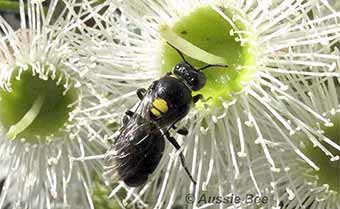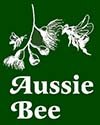PART 1. WHAT IS A BEE HOTEL AND HOW CAN IT HELP?
Aussie Bee > Bee Hotel Guide > Introduction
Native bees need your help
Bee populations in Australia and worldwide are declining due to the growth of our towns and cities.
In the bush, most types of native bees nest in tiny narrow burrows. They may:
-- dig nest tunnels in the ground,
-- excavate nest holes in pithy stems or decaying timber, or
-- build nests inside abandoned holes left by burrowing insects in timber.
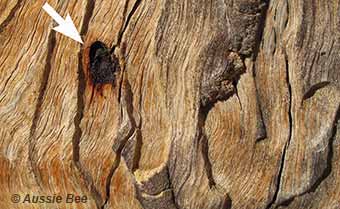
A native resin bee has built a nest in a tiny hole (white arrow) left by a borer in this natural tree trunk. The resin bee has sealed the entrance of her completed nest with some dark red resin.
As our towns and cities spread, many of the trees and shrubs used by native bees are cleared and open ground is replaced by lawns. You can help some varieties of native bees find a place to nest by setting up a Bee Hotel in your garden!
What kinds of native bees use Bee Hotels?
The best known native bees in Australia are our Stingless Bees (Tetragonula and Austroplebeia). These are social bees that produce honey and live in large nests with a queen, males and thousands of workers. Our social Stingless Bees will not use a Bee Hotel. Instead they use big hollows inside mature trees for their nest. They can also be kept in hive boxes.
However, over 99% of Australia's 1,700 native bee species are not social. Many varieties of these bees will use a Bee Hotel. These species do not produce honey but they are great pollinators and fascinating to watch.
-- The solitary bees live all alone in individual nests in small holes or in the ground. Well known varieties include the Blue Banded Bees and Leafcutter Bees.
-- The semi-social bees live in together in small groups. Well known varieties include the Reed Bees, Great Carpenter Bees and Metallic Carpenter Bees.
Types of nests used by our native bees
Around 30% of Australia's solitary and semi-social bees nest in pithy stems or in pre-existing holes in timber. You can help these bees by making a Bee Hotel using short sections of lantana canes, pieces of bamboo and timber blocks with holes drilled in them. Blue Banded Bees dig short burrows in clay soils for their nests. You can also make small clay nesting blocks to support your local Blue Banded Bees. Read Part 2 of our Aussie Bee guide for more details.
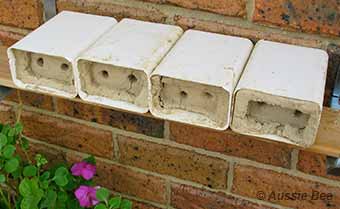
Blue banded bees will build their shallow nests in burrows in these lightweight clay blocks.
The other 70% of Australia's solitary and semi-social bees dig deeper holes in the ground for their nests. It is more difficult to build artificial nest sites for these bees. Successful methods have been found for some species overseas, but in Australia these techniques are still under development. In the meantime, you can encourage these native bees to nest in your garden by leaving areas of ground bare, with no covering of lawn or mulch.
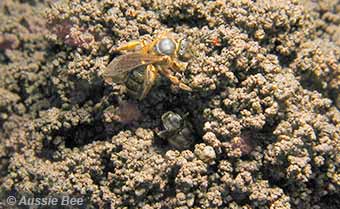
Lasioglossum bees dig deep burrows in the ground for their nests. Can you spot the two Lasioglossum bees at their nest entrance in this mound of soil?
Bee Hotels will boost pollination in your garden
The bees in your Bee Hotel will help to pollinate both your local wildflowers and your vegie garden.
Many solitary bee species pack pollen in loose dry balls on their legs or under their abdomen to carry it back to their nests. In contrast, social bees moisten their pollen with nectar to pack it on their legs. The dry pollen carried by solitary bees may pollinate other flowers better than the moistened pollen carried by social bees. So the solitary bees in your Bee Hotel may be particularly good pollinators for your garden plants.
In addition some solitary and semi-social native bees are able to do a special kind of pollination called 'Buzz Pollination' which Honeybees and our Stingless Bees cannot do. Some crops such as tomatoes, eggplants and blueberries require Buzz Pollination so that their fruit can develop properly. Blue Banded Bees are experts at Buzz Pollination. So if you have a population of these bees in your Bee Hotel, you can expect rich rounded tomatoes in your vegie garden!
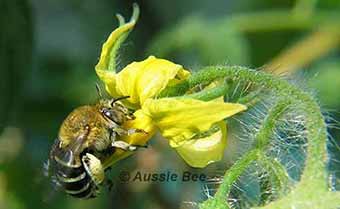
This bluebanded bee is grasping a tomato flower so that she can vibrate it and buzz pollinate it.
Bee Hotels are great educational tools
It is fascinating for young and old to watch native bees bringing pollen, nectar and building materials back to a Bee Hotel! This is a wonderful way to teach kids about the diversity of nature and the behaviour of insects. Students can study the life cycle of bees and learn how bees help pollinate our wildflowers and crops.
Remember, though, that the females of all solitary and semi-social native bees are able to sting. These species are not aggressive as they do not have a queen or large nest resources to defend. In general you would have to actually grab or step on one of these bees to make it sting you. In addition, many are too small to deliver an effective sting to humans. Nevertheless it is possible to be allergic to the sting of some kinds of native bees. So this should be considered if you are planning to set up a Bee Hotel in an educational situation.
Design ideas for your Bee Hotel or Bee Motel
You can make a simple and easy Bee Hotel for your local native bees; or you can let your imagination soar and create an elegant and artistic design [is this a Bee Motel?]. The bees don't mind! As long as you provide dry, safe nest tunnels that suit the bees, they will use it.
Here are some design ideas to get you started:
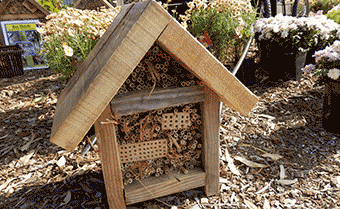
Bee Hotels can be simple or eleborate -- it's up to you! These Bee Hotels were displayed by The Secret Garden in Richmond, NSW, and by Megan Halcroft at the 2017 Willoughby Fair.
NEXT: Part 2. How do I make a Bee Hotel?
Aussie Bee Guide to Bee Hotels
PART 1. What is a Bee Hotel and how can it help?
PART 2. How do I make a Bee Hotel?
PART 3. What bees will use my Bee Hotel?
PART 4. What other insects will use my Bee Hotel?
PART 5. What should I do about pests and parasites?

